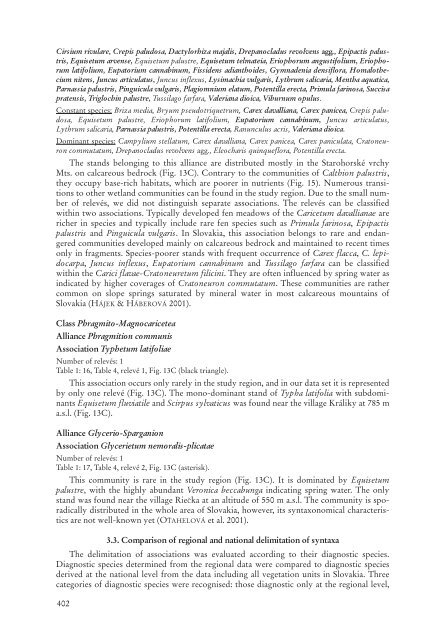Janisova_Tuexenia 30
Janisova_Tuexenia 30
Janisova_Tuexenia 30
Create successful ePaper yourself
Turn your PDF publications into a flip-book with our unique Google optimized e-Paper software.
Cirsium rivulare, Crepis paludosa, Dactylorhiza majalis, Drepanocladus revolvens agg., Epipactis palustris,<br />
Equisetum arvense, Equisetum palustre, Equisetum telmateia, Eriophorum angustifolium, Eriophorum<br />
latifolium, Eupatorium cannabinum, Fissidens adianthoides, Gymnadenia densiflora, Homalothecium<br />
nitens, Juncus articulatus, Juncus inflexus, Lysimachia vulgaris, Lythrum salicaria, Mentha aquatica,<br />
Parnassia palustris, Pinguicula vulgaris, Plagiomnium elatum, Potentilla erecta, Primula farinosa, Succisa<br />
pratensis, Triglochin palustre, Tussilago farfara, Valeriana dioica, Viburnum opulus.<br />
Constant species: Briza media, Bryum pseudotriquetrum, Carex davalliana, Carex panicea, Crepis paludosa,<br />
Equisetum palustre, Eriophorum latifolium, Eupatorium cannabinum, Juncus articulatus,<br />
Lythrum salicaria, Parnassia palustris, Potentilla erecta, Ranunculus acris, Valeriana dioica.<br />
Dominant species: Campylium stellatum, Carex davalliana, Carex panicea, Carex paniculata, Cratoneuron<br />
commutatum, Drepanocladus revolvens agg., Eleocharis quinqueflora, Potentilla erecta.<br />
The stands belonging to this alliance are distributed mostly in the Starohorské vrchy<br />
Mts. on calcareous bedrock (Fig. 13C). Contrary to the communities of Calthion palustris,<br />
they occupy base-rich habitats, which are poorer in nutrients (Fig. 15). Numerous transitions<br />
to other wetland communities can be found in the study region. Due to the small number<br />
of relevés, we did not distinguish separate associations. The relevés can be classified<br />
within two associations. Typically developed fen meadows of the Caricetum davallianae are<br />
richer in species and typically include rare fen species such as Primula farinosa, Epipactis<br />
palustris and Pinguicula vulgaris. In Slovakia, this association belongs to rare and endangered<br />
communities developed mainly on calcareous bedrock and maintained to recent times<br />
only in fragments. Species-poorer stands with frequent occurrence of Carex flacca, C. lepidocarpa,<br />
Juncus inflexus, Eupatorium cannabinum and Tussilago farfara can be classified<br />
within the Carici flavae-Cratoneuretum filicini. They are often influenced by spring water as<br />
indicated by higher coverages of Cratoneuron commutatum. These communities are rather<br />
common on slope springs saturated by mineral water in most calcareous mountains of<br />
Slovakia (HÁJEK & HÁBEROVÁ 2001).<br />
Class Phragmito-Magnocaricetea<br />
Alliance Phragmition communis<br />
Association Typhetum latifoliae<br />
Number of relevés: 1<br />
Table 1: 16, Table 4, relevé 1, Fig. 13C (black triangle).<br />
This association occurs only rarely in the study region, and in our data set it is represented<br />
by only one relevé (Fig. 13C). The mono-dominant stand of Typha latifolia with subdominants<br />
Equisetum fluviatile and Scirpus sylvaticus was found near the village Králiky at 785 m<br />
a.s.l. (Fig. 13C).<br />
Alliance Glycerio-Sparganion<br />
Association Glycerietum nemoralis-plicatae<br />
Number of relevés: 1<br />
Table 1: 17, Table 4, relevé 2, Fig. 13C (asterisk).<br />
This community is rare in the study region (Fig. 13C). It is dominated by Equisetum<br />
palustre, with the highly abundant Veronica beccabunga indicating spring water. The only<br />
stand was found near the village Riečka at an altitude of 550 m a.s.l. The community is sporadically<br />
distributed in the whole area of Slovakia, however, its syntaxonomical characteristics<br />
are not well-known yet (OŤAHELOVÁ et al. 2001).<br />
3.3. Comparison of regional and national delimitation of syntaxa<br />
The delimitation of associations was evaluated according to their diagnostic species.<br />
Diagnostic species determined from the regional data were compared to diagnostic species<br />
derived at the national level from the data including all vegetation units in Slovakia. Three<br />
categories of diagnostic species were recognised: those diagnostic only at the regional level,<br />
402


